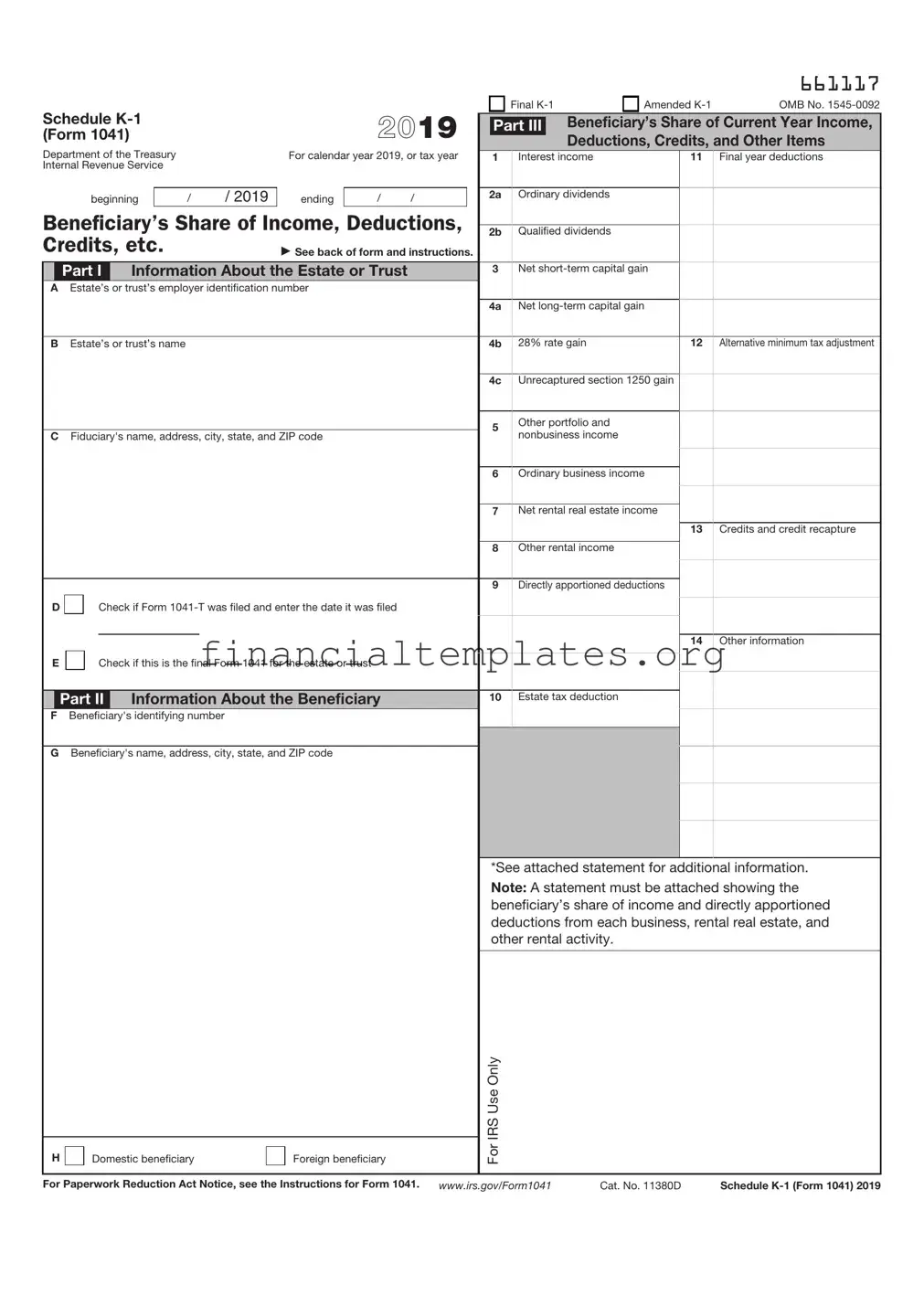
|
|
|
|
|
|
|
|
|
|
|
|
|
|
|
|
|
|
|
|
|
661117 |
Schedule K-1 |
|
|
|
|
2021 |
|
|
|
Final K-1 |
|
Amended K-1 |
OMB No. 1545-0092 |
|
|
|
|
|
|
Part III |
|
Beneficiary’s Share of Current Year Income, |
(Form 1041) |
|
|
|
|
|
|
|
|
|
Deductions, Credits, and Other Items |
|
|
|
|
|
|
|
|
|
|
|
Department of the Treasury |
|
|
For calendar year 2021, or tax year |
1 |
Interest income |
|
11 |
Final year deductions |
Internal Revenue Service |
|
|
|
|
|
|
|
|
|
|
|
|
|
|
|
|
|
|
|
|
|
|
|
|
|
|
|
|
|
|
|
|
|
|
|
|
|
|
beginning |
|
/ |
/ |
ending |
|
/ |
/ |
|
2a |
Ordinary dividends |
|
|
|
|
|
|
|
|
|
|
|
|
|
|
|
|
Beneficiary’s Share of Income, Deductions, |
|
|
|
|
|
2b |
Qualified dividends |
|
|
|
Credits, etc. |
|
|
▶ See back of form and instructions. |
|
|
|
|
|
|
|
|
|
|
Part I |
|
Information About the Estate or Trust |
|
|
3 |
Net short-term capital gain |
|
|
A Estate’s or trust’s employer identification number |
|
|
|
|
|
|
|
|
|
|
|
|
|
|
|
|
|
|
|
|
|
|
|
|
|
|
|
|
|
|
|
|
|
|
|
|
|
|
|
|
|
|
|
4a |
Net long-term capital gain |
|
|
|
|
|
|
|
|
|
|
|
|
|
|
|
B Estate’s or trust’s name |
|
|
|
|
|
|
|
4b |
28% rate gain |
|
12 |
Alternative minimum tax adjustment |
|
|
|
|
|
|
|
|
|
|
|
|
|
|
|
|
|
|
|
|
|
|
|
|
|
|
|
|
|
|
|
|
4c |
Unrecaptured section 1250 gain |
|
|
|
|
|
|
|
|
|
|
|
|
|
|
|
|
|
|
|
|
|
|
|
|
|
|
|
|
|
|
|
|
|
|
|
|
5 |
Other portfolio and |
|
|
|
C Fiduciary’s name, address, city, state, and ZIP code |
|
|
|
nonbusiness income |
|
|
|
|
|
|
|
|
|
|
|
|
|
|
|
|
|
|
|
|
|
|
|
|
|
|
|
|
|
|
|
|
|
|
|
|
|
|
|
|
|
|
|
|
|
|
|
|
|
|
|
|
|
|
|
|
|
|
|
|
|
|
|
|
|
6 |
Ordinary business income |
|
|
|
|
|
|
|
|
|
|
|
|
|
|
|
|
|
|
|
|
|
|
|
|
|
|
|
|
|
|
|
|
|
|
|
|
|
|
|
|
|
|
|
|
|
|
|
|
|
|
|
|
|
|
|
|
7 |
Net rental real estate income |
|
|
|
|
|
|
|
|
|
|
|
|
|
|
|
|
|
|
|
|
|
|
|
|
|
|
|
|
|
|
|
|
|
|
|
|
|
|
|
|
|
|
|
|
13 |
Credits and credit recapture |
|
|
|
|
|
|
|
|
|
|
|
|
|
|
|
|
|
|
|
|
|
|
|
|
|
|
|
|
|
|
|
|
|
8 |
Other rental income |
|
|
|
|
|
|
|
|
|
|
|
|
|
|
|
|
|
|
|
|
|
|
|
|
|
|
|
|
|
|
|
|
|
|
|
|
|
|
|
|
|
|
|
|
|
|
|
|
|
|
|
|
|
|
|
|
|
9 |
Directly apportioned deductions |
|
|
D |
|
Check if Form 1041-T was filed and enter the date it was filed |
|
|
|
|
|
|
|
|
|
|
|
|
|
|
|
|
|
|
|
|
|
|
|
|
|
|
|
|
|
|
|
|
|
|
|
|
|
|
|
|
|
|
|
|
|
|
|
|
|
|
|
|
|
|
|
|
|
|
|
|
|
|
|
|
|
|
|
|
|
|
|
|
|
|
|
|
|
|
|
|
|
|
|
|
14 |
Other information |
E |
|
Check if this is the final Form 1041 for the estate or trust |
|
|
|
|
|
|
|
|
|
|
|
|
|
|
|
|
|
|
|
|
|
|
|
|
|
|
|
|
|
|
|
|
|
|
|
|
|
|
|
|
|
|
|
|
|
|
Part II |
|
Information About the Beneficiary |
|
|
10 |
Estate tax deduction |
|
|
|
F |
Beneficiary’s identifying number |
|
|
|
|
|
|
|
|
|
|
|
|
|
|
|
|
|
|
|
|
|
|
|
|
|
|
|
|
|
|
|
|
|
|
|
|
|
|
|
|
|
|
|
|
|
|
|
G Beneficiary’s name, address, city, state, and ZIP code |
|
|
|
|
|
|
|
|
|
|
|
|
|
|
|
|
|
|
|
|
|
|
|
|
|
|
|
|
|
|
|
|
|
|
|
|
|
|
|
|
|
|
|
|
|
|
|
|
|
|
|
|
|
|
|
|
|
|
|
|
|
|
|
|
|
|
|
|
|
|
|
|
|
|
|
|
|
*See attached statement for additional information.
Note: A statement must be attached showing the beneficiary’s share of income and directly apportioned deductions from each business, rental real estate, and other rental activity.
|
|
|
|
|
For IRS Use Only |
H |
|
Domestic beneficiary |
|
Foreign beneficiary |
|
|
For Paperwork Reduction Act Notice, see the Instructions for Form 1041. |
www.irs.gov/Form1041 |
Cat. No. 11380D |
Schedule K-1 (Form 1041) 2021 |
C AMT adjustment attributable to net short-term capital gain
D AMT adjustment attributable to net long-term capital gain
E AMT adjustment attributable to unrecaptured section 1250 gain
F Net operating loss carryover — minimum tax
D Long-term capital loss carryover
E Net operating loss carryover — regular tax
C Short-term capital loss carryover
O Biodiesel and renewable diesel fuels credit
P Credit to holders of tax credit bonds
Q Credit for employer differential wage payments
Form 8960, line 7 (also see the beneficiary’s instructions)
See the beneficiary’s instructions See the beneficiary’s instructions
Form 4952, line 4a Schedule E, line 42
See the Instructions for Form 8873
Form 1040 or 1040-SR, line 2a
Schedule 3 (Form 1040), line 1 or Sch. A, line 6
See the beneficiary’s instructions
Schedule K-1 (Form 1041) 2021 |
Page 2 |
This list identifies the codes used on Schedule K-1 for beneficiaries and provides summarized reporting information for beneficiaries who file Form 1040 or 1040-SR. For detailed reporting and filing information, see the Instructions for Schedule K-1 (Form 1041) for a Beneficiary Filing Form 1040 or 1040-SR and the instructions for your income tax return.
|
|
Report on |
1. |
Interest income |
Form 1040 or 1040-SR, line 2b |
2a. Ordinary dividends |
Form 1040 or 1040-SR, line 3b |
2b. Qualified dividends |
Form 1040 or 1040-SR, line 3a |
3. |
Net short-term capital gain |
Schedule D, line 5 |
4a. Net long-term capital gain |
Schedule D, line 12 |
4b. 28% rate gain |
28% Rate Gain Worksheet, line 4 |
|
|
(Schedule D Instructions) |
4c. Unrecaptured section 1250 gain |
Unrecaptured Section 1250 Gain |
|
|
Worksheet, line 11 (Schedule D |
|
|
Instructions) |
5. Other portfolio and nonbusiness |
Schedule E, line 33, column (f) |
|
income |
|
6. |
Ordinary business income |
Schedule E, line 33, column (d) |
|
|
or (f) |
7. |
Net rental real estate income |
Schedule E, line 33, column (d) |
|
|
or (f) |
8. |
Other rental income |
Schedule E, line 33, column (d) |
|
|
or (f) |
9.Directly apportioned deductions Code
13. Credits and credit recapture |
|
Code |
Report on |
A Credit for estimated taxes |
Form 1040 or 1040-SR, line 26 |
B Credit for backup withholding |
Form 1040 or 1040-SR, line 25c |
C Low-income housing credit |
|
D Rehabilitation credit and energy credit |
|
E Other qualifying investment credit |
|
F Work opportunity credit |
|
G Credit for small employer health |
|
insurance premiums |
|
H Biofuel producer credit |
|
ICredit for increasing research activities
JRenewable electricity, refined coal, and Indian coal production credit
K Empowerment zone employment credit} L Indian employment credit
M Orphan drug credit
N Credit for employer-provided child care and facilities
ADepreciation
BDepletion
CAmortization
10.Estate tax deduction
11.Final year deductions
AExcess deductions – Section 67(e) expenses
Form 8582 or Schedule E, line 33, column (c) or (e)
Form 8582 or Schedule E, line 33, column (c) or (e)
Form 8582 or Schedule E, line 33, column (c) or (e)
Schedule A, line 16
See the beneficiary’s instructions
R Recapture of credits Z Other credits
14. Other information A Tax-exempt interest B Foreign taxes
B Excess deductions – Non–miscellaneous See the beneficiary’s instructions itemized deductions
Schedule D, line 5
Schedule D, line 12; line 5 of the wksht. for Sch. D, line 18; and line 16 of the wksht. for Sch. D, line 19
Schedule 1 (Form 1040), line 8a
12. Alternative minimum tax (AMT) items}Form 6251, line 2f A Adjustment for minimum tax purposes Form 6251, line 2j
B AMT adjustment attributable to qualified dividends
See the beneficiary’s instructions and the Instructions for Form 6251
FAMT adjustment attributable to 28% rate gain
GAccelerated depreciation
HDepletion
I Amortization |
|
J Exclusion items |
2022 Form 8801 |
C Reserved for future use
D Reserved for future use E Net investment income
F Gross farm and fishing income
G Foreign trading gross receipts (IRC 942(a))
H Adjustment for section 1411 net investment income or deductions
I Section 199A information
Z Other information
Note: If you are a beneficiary who does not file a Form 1040 or 1040-SR, see instructions for the type of income tax return you are filing.


